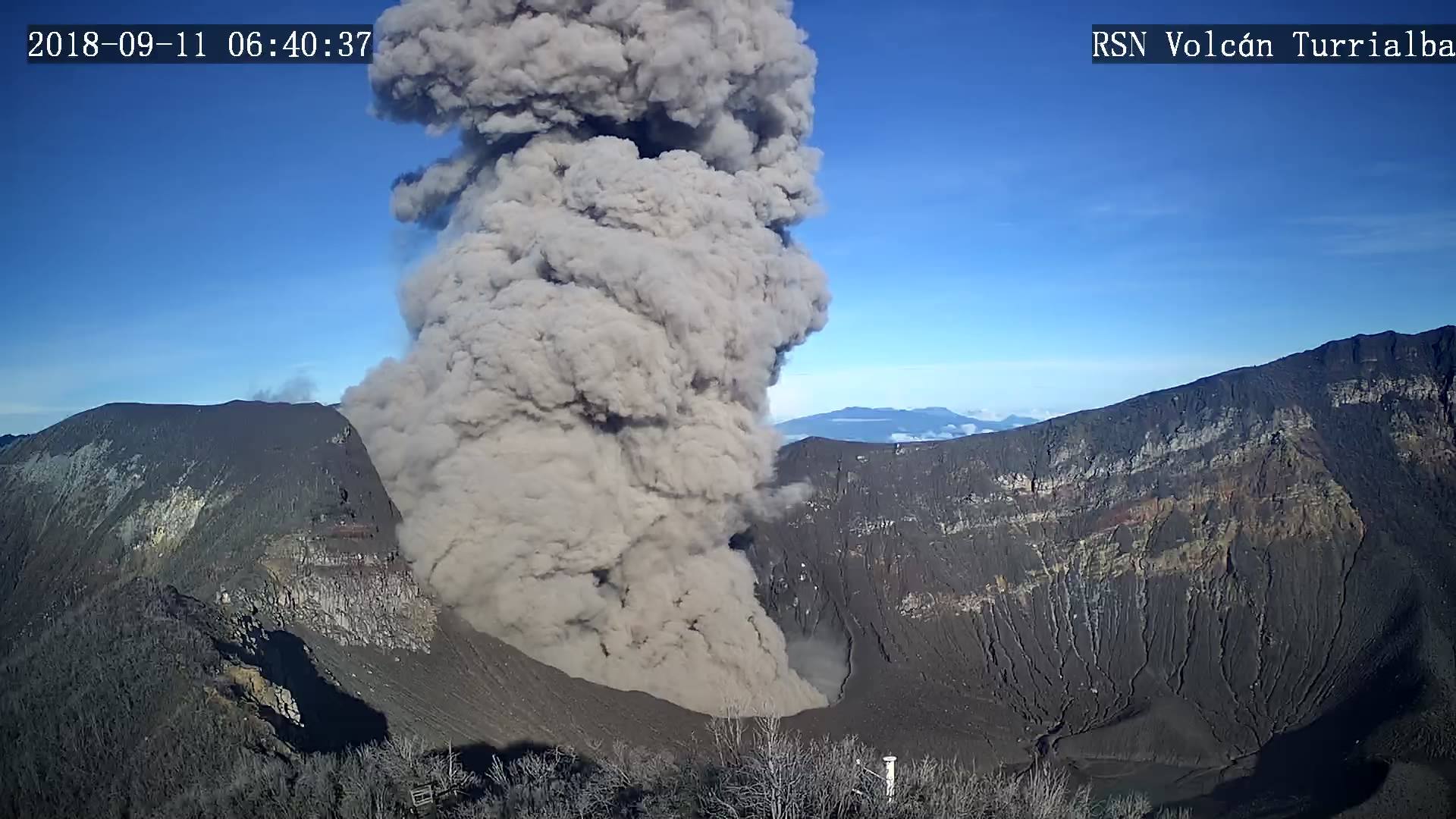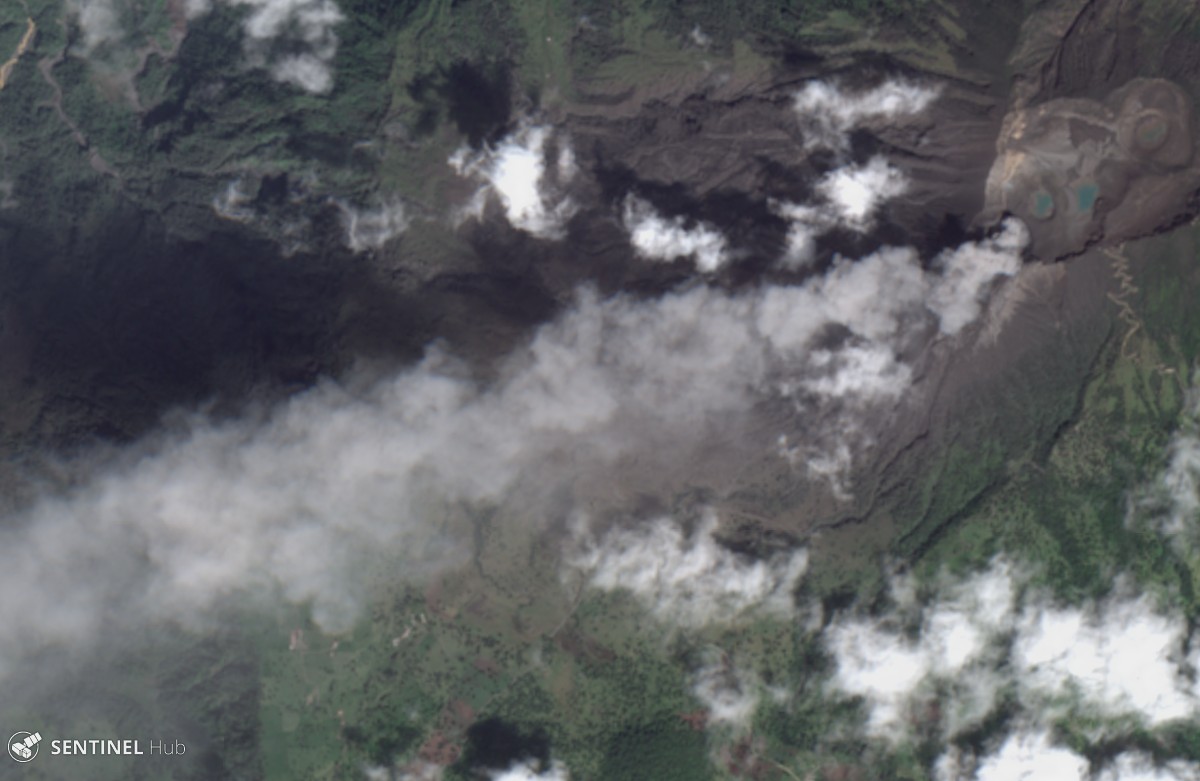Report on Turrialba (Costa Rica) — April 2019
Bulletin of the Global Volcanism Network, vol. 44, no. 4 (April 2019)
Managing Editor: Edward Venzke.
Research and preparation by Paul Berger.
Turrialba (Costa Rica) Frequent passive ash emissions continue through February 2019
Please cite this report as:
Global Volcanism Program, 2019. Report on Turrialba (Costa Rica) (Venzke, E., ed.). Bulletin of the Global Volcanism Network, 44:4. Smithsonian Institution. https://doi.org/10.5479/si.GVP.BGVN201904-345070
Turrialba
Costa Rica
10.025°N, 83.767°W; summit elev. 3340 m
All times are local (unless otherwise noted)
This report summarizes activity at Turrialba during September 2018-February 2019. During this period there was similar activity as described earlier in 2018 (BGVN 43:09), with occasional ash explosions and numerous, sometimes continuous, periods of gas-and-ash emissions (table 8). Data were provided by the Observatorio Vulcanologico Sismologica de Costa Rica-Universidad Nacional (OVSICORI-UNA).
Table 8. Ash emissions at Turrialba, September 2018-February 2019. Cloudy weather sometimes obscured observations. Maximum plume height is above the crater rim. Information courtesy of OVSICORI-UNA.
| Date | Time | Max plume height | Plume drift | Remarks |
| 27 Aug-05 Sep 2018 | -- | 100 m | SW, W | Continuous gas-and-ash emissions. |
| 06 Sep 2018 | -- | -- | -- | Mostly gas, punctuated by small sporadic ash plumes. |
| 10 Sep 2018 | 1210 | 300 m | NW | -- |
| 01-13 Sep 2018 | -- | -- | -- | Continuous gas-and-ash emissions. |
| 17-18 Sep 2018 | -- | 300 m | SW, NW | -- |
| 27 Sep 2018 | 0915 | 200 m | NW | -- |
| 30 Sep-01 Oct 2018 | -- | 500 m | NW, NE | -- |
| 03 Oct 2018 | -- | -- | -- | Incandescence. |
| 08 Oct 2018 | 0800 | 500 m | N | -- |
| 10-16 Oct 2018 | -- | 1,000 m | Various | Intermittent emissions; some explosions, including an energetic one on 14 Oct at 1712. Clouds prevented estimate of plume height. |
| 17-23 Oct 2018 | -- | 200-500 m | E, NW, SW | Periodic gas-and-ash emissions. Frequent Strombolian events since 5 Oct. |
| 25-30 Oct 2018 | -- | -- | -- | Periodic ash emissions when weather conditions allowed observations. |
| 26 Oct 2018 | 0134 | 500 m | NE | Ashfall in neighborhoods of Coronado (San José, 35 km WSW) and San Isidro de Heredia (Heredia, 38 km W). |
| 29 Oct 2018 | 0231 | 500 m | NW | -- |
| 30 Oct 2018 | 1406 | 500 m | W | -- |
| 24 Oct-01 Nov 2018 | -- | 500 m | -- | Continuous emissions. |
| 01-06 Nov 2018 | 0530-0640 | 500 m | SW | -- |
| 02 Nov 2018 | 1523, 1703 | 500 m | -- | -- |
| 03 Nov 2018 | 0109 | 500 m | -- | Short (2-3 minutes) duration events. Ashfall reported in Coronado. |
| 05 Nov 2018 | 0620 | 600 m | NW | -- |
| 06-11 Nov 2018 | -- | 500 m | -- | Low-level, continuous gas-and-ash emissions occasionally punctuated by energetic explosions that sent plumes as high as 500 m and caused ashfall in several areas downwind, including Cascajal de Coronado, Desamparados (35 km WSW), San Antonio, Guadalupe (32 km WSW), Sabanilla, San Pedro Montes de Oca, Moravia (31 km WSW), Heredia, and Coronado (San José, 35 km WSW). Weather prevented observations on 12 Nov. |
| 13-19 Nov 2018 | -- | -- | -- | Periodic, passive ash emissions visible in webcam images or during cloudy conditions inferred from the seismic data. |
| 22 Nov 2018 | 0710 | 100 m | W | -- |
| 23 Nov 2018 | -- | -- | -- | Frequent pulses of ash. |
| 23-25 Nov 2018 | -- | 500 m | -- | Occasional Strombolian explosions ejected lava bombs deposited near the crater; residents of Cascajal de Coronado reported hearing several booming sounds. |
| 26-27 Nov 2018 | -- | -- | -- | Passive emissions with small quantities of ash visible. Minor ashfall in San Jose (Cascajal de Coronado and Dulce Nombre), San Pedro Montes de Oca, and neighborhoods of Heredia. |
| 28 Nov-03 Dec 2018 | -- | 500 m | N, NW, SW | Ashfall in Santo Domingo (36 km WSW) on 2 Dec. |
| 05 Dec 2018 | -- | -- | -- | Minor emission. |
| 06 Dec 2018 | -- | -- | S | Emission. |
| 08 Dec 2018 | 0749 | 500 m | NW | -- |
| 09 Dec 2018 | -- | 1,000 m | -- | Ashfall in areas of Valle Central. |
| 10 Dec 2018 | -- | -- | -- | Emissions periodically observed during periods of clear viewing. Ashfall in Moravia (31 km WSW) and Santa Ana, and residents of Heredia noted a sulfur odor. |
| 11-12 Dec 2018 | -- | 500 m | NW, SW | The Tico Times stated some flights were delayed at San Jose airport, 67 km away. |
| 13 Dec 2018 | -- | -- | -- | Pulsing ash emissions; ashfall in Guadalupe (32 km WSW) and Valle Central. |
| 14-16 Dec 2018 | -- | -- | W, SW | Emissions with diffuse amounts of ash. |
| 05-06 Jan 2019 | 0815 | -- | -- | Increased after midnight on 6 Jan. |
| 28 Jan-04 Feb 2019 | -- | -- | -- | Minor, sporadic ash emissions rose to low heights during most days. |
| 01 Feb 2019 | 0640 | 1,500 m | NW | -- |
| 08 Feb 2019 | 0540 | 200 m | -- | Sporadic ash emissions for more than one hour. |
| 11 Feb 2019 | -- | -- | -- | Very small ash emission. |
| 13-15 Feb 2019 | 200-300 m | NW, W, SW | Almost continuous gas emissions with minor ash content. | |
| 15 Feb 2019 | 1330 | 1,000 m | W | -- |
| 18 Feb 2019 | 1310 | 500 m | W | -- |
| 21 Feb 2019 | -- | 300 m | NW | Frequent ash pulses. |
| 22-24 Feb 2019 | -- | 300 m | NW, SW | Frequent ash emissions of variable intensity and duration. On 22 Feb ash fell in Santa Cruz (31 km WSW) and Santa Ana, and a sulfur odor was evident in Moravia. |
| 28 Feb 2019 | 1050 | 500 m | SW | Ash pulses. |
According to OVSICORI-UNA's annual summary for 2018, a slow decline in activity occurred after the volcano reached its highest emission rate during 2016. Activity during 2018 was consistent with an open system, generating frequent passive ash emissions. The volcano emitted ash on 58% of the days during the year. Some explosions were large enough to eject ballistics more than 400 m around the crater. Typical activity can be seen in a photo from 11 September 2018 (figure 50) and satellite imagery on 7 November 2018 (figure 51).
 |
Figure 50. Photo of an ash explosion at Turrialba taken on 11 September 2018. Courtesy of Red Sismologica Nacional (RSN: UCR-ICE), Universidad de Costa Rica. |
 |
Figure 51. Sentinel-2 satellite image of an ash emission from Turrialba on 7 November 2018, taken in natural color (gamma adjusted). Courtesy of Sentinel Hub Playground. |
During January into early February 2019, passive ash emissions continued irregularly and with less intensity and duration. Emissions sometimes lacked ash. In their report of 4 February 2019, OVSICORI-UNA indicated that passive ash emissions were weak and slow. For the rest of February, they characterized ash emissions as frequent, but of low intensity.
Seismic activity. On 1 November 2018 OVSICORI-UNA reported that seismicity remained high, and involved low-amplitude banded volcanic tremor along with long-period (LP) and volcano-tectonic (VT) earthquakes. In late January-early February 2019, OVSICORI-UNA reported that seismicity remained relatively stable, although a small increase was associated with the hydrothermal system. VT earthquakes were absent, and tremors had decreased in both energy and duration. The number of low-frequency LP volcanic earthquakes remained stable, although they had decreasing amplitudes. No explosions were documented, and emissions were weak and had short durations and very dilute ash content.
Thermal anomalies. No thermal anomalies were recorded during the reporting period using MODIS satellite instruments processed by MODVOLC algorithm. The MIROVA (Middle InfraRed Observation of Volcanic Activity) system detected five scattered hotspots during September-October 2018, none during November-December 2018, and two during January-February 2019. All were within 2 km of the volcano and of low radiative power.
Gas measurements. Significant sulfur dioxide levels near the volcano were recorded by NASA's satellite-borne ozone instruments only on 29 September 2018 (both NPP/OMPS and Aura/OMI instruments) and on 11 February 2019 (Sentinel 5P/TROPOMI instrument). OVSICORI-UNA's gas measuring instruments were compromised in September 2018 through January 2019 due to vandalism. In early February, however, they detected hydrogen sulfide for the first time since 2016.
Geological Summary. Turrialba, the easternmost of Costa Rica's Holocene volcanoes, is a large vegetated basaltic-to-dacitic stratovolcano located across a broad saddle NE of Irazú volcano overlooking the city of Cartago. The massive edifice covers an area of 500 km2. Three well-defined craters occur at the upper SW end of a broad 800 x 2200 m summit depression that is breached to the NE. Most activity originated from the summit vent complex, but two pyroclastic cones are located on the SW flank. Five major explosive eruptions have occurred during the past 3500 years. A series of explosive eruptions during the 19th century were sometimes accompanied by pyroclastic flows. Fumarolic activity continues at the central and SW summit craters.
Information Contacts: Observatorio Vulcanologico Sismologica de Costa Rica-Universidad Nacional (OVSICORI-UNA), Apartado 86-3000, Heredia, Costa Rica (URL: http://www.ovsicori.una.ac.cr/); Red Sismologica Nacional (RSN) a collaboration between a) the Sección de Sismología, Vulcanología y Exploración Geofísica de la Escuela Centroamericana de Geología de la Universidad de Costa Rica (UCR), and b) the Área de Amenazas y Auscultación Sismológica y Volcánica del Instituto Costarricense de Electricidad (ICE), Costa Rica (URL: https://rsn.ucr.ac.cr/); Sentinel Hub Playground (URL: https://www.sentinel-hub.com/explore/sentinel-playground); Hawai'i Institute of Geophysics and Planetology (HIGP) - MODVOLC Thermal Alerts System, School of Ocean and Earth Science and Technology (SOEST), Univ. of Hawai'i, 2525 Correa Road, Honolulu, HI 96822, USA (URL: http://hotspot.higp.hawaii.edu/); MIROVA (Middle InfraRed Observation of Volcanic Activity), a collaborative project between the Universities of Turin and Florence (Italy) supported by the Centre for Volcanic Risk of the Italian Civil Protection Department (URL: http://www.mirovaweb.it/); Global Sulfur Dioxide Monitoring Page, Atmospheric Chemistry and Dynamics Laboratory, NASA Goddard Space Flight Center (NASA/GSFC), 8800 Greenbelt Road, Goddard, Maryland, USA (URL: https://so2.gsfc.nasa.gov/); Costa Rica Star (URL: https://news.co.cr); The Tico Times (URL: https://ticotimes.net).

